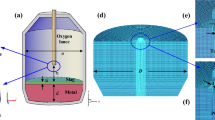Abstract
The formation of slag eye in a gas stirred ladle was studied through cold models and industrial trials. In the cold model, water and sodium tungstate solution were employed to simulate liquid steel, and silicon oil was employed to simulate slag. The simulation results revealed that the gas flow rate and bath height had strong effects on the slag eye size. In particular, the thickness of slag layer played a strong role in the slag eye size. In addition, the slag eye could not be formed when the thickness of the top layer was more than 4 cm in water-silicone oil model. Besides, the section area of vessel had a great impact on the slag eye size. Industrial trials results showed a similar trend that the gas flow rate was very significant on the slag eye size. The predictions of the existing models showed larger predictions deviations compared with the experimental data. Moreover, a new model without fitting parameters was developed based on force balance and mathematical derivation, and verified by the experimental data. The new model provides the prediction with small deviations by comparing with the data acquired from cold models and industrial trials.
Similar content being viewed by others
Abbreviations
- A :
-
Area of section A″B, cm2
- A e :
-
Slag eye size, cm2
- A α :
-
Section area of vessel, cm2
- A p :
-
Plum size, cm2
- \(A_{\text{e}}^*\) :
-
Dimensionless slag eye
- \(A_{\text{p}}^*\) :
-
Dimensionless plume
- d :
-
Nozzle diameter, mm
- D 0 :
-
Ladle diameter, cm
- D e :
-
Slag eye diameter, cm
- D p :
-
Plume diameter, cm
- Fr :
-
Froude number
- Fr*:
-
Densimetric Froude number
- g :
-
Acceleration of gravity, cm • s−2
- h 0 :
-
Upper phase (slag) thickness without gas blowing, cm
- h :
-
Upper phase (slag) thickness with gas blowing, cm
- H :
-
Depth of bulk phase fluid in ladle, cm
- j :
-
Unit vector in vertical direction
- K1, K2:
-
Constants
- \(\hat n\) :
-
Unit normal vector
- Pa, Pb:
-
Pressures at top and bottom, respectively, of control volume, Pa
- Q :
-
Gas flow rate, cm3 • s−1
- s :
-
Ratio of thickness of top phase to depth of bulk phase
- U 0 :
-
Velocity of downward flow in control volume, cm • s−1
- U p :
-
Plume velocity (average rise velocity of two-phase mixture), cm • s-1
- U pmax :
-
Maximum of plume velocity, cm • s−1
- v :
-
Component of velocity vector
- V :
-
Velocity vector
- W :
-
Mass of water contained in control volume, g
- α, ß, γ:
-
Constants
- θ:
-
Vertical angle of downward flow in control volume
- μs:
-
Kinematic viscosity, cm2 • s−1
- ρo:
-
Density of oil, g • cm−3
- ρ:
-
Density of water, g • cm−3
- ρs:
-
Density of upper liquid, g • cm−3
- ρm:
-
Density of bulk phase liquid, g • cm−3
- Δρ:
-
Difference between top liquid and bulk liquid, g • cm−3
- Ψ:
-
Gas fraction in plume
- χ:
-
Numerical value
References
V. S. Laktionov, S. I. Filippov, P. I. Melikhov, S. N. Paderion, V. A. Borisova, Metallurgist 15 (1971) 515–517.
P. Dayal, K. Beskow, J. Björkvall, S. C. Du, Ironmak. Steelmak. 33 (2006) 454–464.
H. Lachmund, Y. K. Xie, T. Buhes, W. Pluschkell, Steel Res. Int. 74 (2003) 77–85.
T. X. Wei, F. Oeteys, Steel Res. Int. 63 (1992) 60–68.
D. Mazumdar, J. W. Evans, Metall. Mater. Trans. B 35 (2004) 400–404.
K. Yonezawa, K. Schwerdtfeger, Metall. Mater. Trans. B 30 (1999) 411–418.
Subagyo, G. A. Brooks, G. A. Irons, ISIJ Int. 43 (2003) 262–263.
M. Iguchi, K. Miyamoto, S. Yamashita, D. Iguchi, M. Zeze, ISIJ Int. 44 (2004) 636–638.
D. Mazumdar, J. W. Evans, Metall. Mater. Trans. B 38 (2007) 497–499.
K. Krishnapisharody, G. A. Irons, Metall. Mater. Trans. B 37 (2006) 763–772.
K. Krishnapisharody, G. A. Irons, ISIJ Int. 48 (2008) 1807–1809.
M. Peranandhanthan, D. Mazumdar, ISIJ Int. 50 (2010) 1622–1631.
L. Wu, P. Valentin, D. Sichen, Steel Res. Int. 81 (2010) 508–515.
K. Krishnapisharody, G. A. Irons, Metall. Mater. Trans. B 46 (2015) 191–198.
M. Iguchi, H. Kawabata, K. Nakajima, Z. I. Morita, Metall. Mater. Trans. B 26 (1995) 67–73.
M. Iguchi, H. Tokunaga, Metall. Mater. Trans. B 33 (2002) 695–702.
Author information
Authors and Affiliations
Corresponding author
Rights and permissions
About this article
Cite this article
Lv, Nn., Wu, Ls., Wang, Hc. et al. Size analysis of slag eye formed by gas blowing in ladle refining. J. Iron Steel Res. Int. 24, 243–250 (2017). https://doi.org/10.1016/S1006-706X(17)30036-5
Received:
Revised:
Accepted:
Published:
Issue Date:
DOI: https://doi.org/10.1016/S1006-706X(17)30036-5



